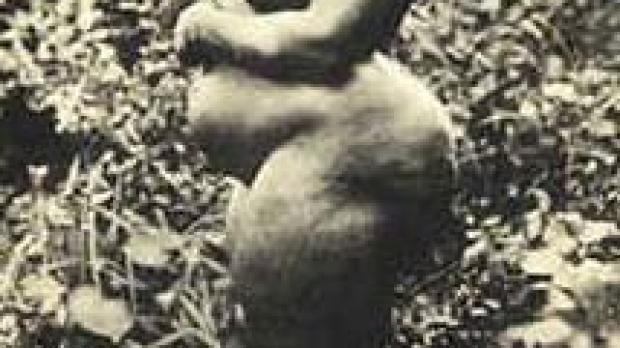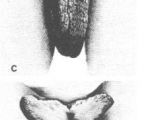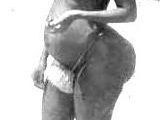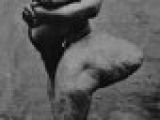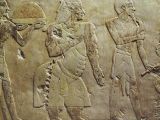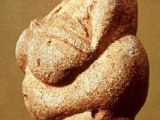Steatopygia is a high degree of fat accumulation in and around the buttocks.
The deposit of fat is not confined to the buttock regions, but extends to the outside and front of the thighs, forming a thick layer reaching sometimes to the knee.
This is a widespread genetic trait of the Khoisan (more commonly known as Bushmen).
It is specially a female feature, but it occurs in a lesser degree at men too (in most genetic variations of Homo sapiens, females tend to exhibit a greater propensity to fat tissue accumulation in the buttock region as compared with males).
This trait is also found amongst the Pygmies of Central Africa or from Andaman Islands (Southeast Asia).
Khoisan see this as a beauty sign: it begins in infancy and is fully developed by the time of the first pregnancy.
Steatopygia is often accompanied by the formation of elongated labia (labia minora may extend as much as 4 inches (10 cm) (!) outside the vulva).
Look how a Boer in the XVIII the century describes this trait:
"The lining of the body appears to be loose, so that in certain places part of it dangles out. They have to themselves this peculiarity from other races that most of them possess finger-shaped appendages, always double, hanging down from the private parts; these are evidently nymphae (labia minora)."
James Cook, the famous British navigator, noted in 1771, while passing by Cape colony:
"The great question among natural historians, whether the women of this country have or have not that fleshy flap or apron which has been called the Sinus pudoris. The most recent testimony of travellers commands us to put the cutaneous ventrale of female Hottentots in the same category as the human tail, and in like manner to relegate it to the fables."
Steatopygia was studied for the first time by scientists in 1805, by French zoologists P?ron and Lesueur, but at that time, many thought this was inaccurate or exaggerated, or that they had examined monstrosities and represented them as normal, or perhaps the subject may had been regarded as indelicate.
The labia forms can vary amongst Bushmen populations: in South West Africa, each labium is flattened and broadened to form a wing-like object, when laid out flat (the 'butterfly' type) while in Botswana and the Cape Province of South Africa the width is reduced and the anterior part thickened, resulting in an object like the wattle of a turkey-cock.
The 'wattle' type is commonly 3-4" long (7? - 10 cm), the 'butterfly' l? - 2" (3.8 - 6.3 cm).
Pygmies (both from Africa and Asia) and Bushmen are seen as the remnants of the most archaic current races and once, they inhabited most of Africa, from the Gulf of Aden to the Cape of Good Hope and all southern Asia till New Guinea.
Hottentots, of mixed Bushmen-Bantu roots, also often present this trait, as do Basters, mulattoes between Boers and Bushmen or Hottentots, while at the Khoisan, males can present steatopygia more often than Hottentot women.
It seems that steatopygia in both sexes was common in early types of Homo sapiens.
Paleolithic figurines and cave paintings from Europe depicting women, some as old as 30,000 years, clearly display stetopygia.
Those Cro-Magnon were more similar racially to the current Bushmen and Pygmies than any current European type.
However, the type of Neolithic Venus figurines (about 10,000 years old) do not strictly match steatopygia, since they have an angle of about 120 degrees between the back and the buttocks, while steatopygia is characterized at an angle of just about 90 degrees.
In 3500 years old Egyptian painting, the queen of Punt is presented displaying steatopygia, so this country still not precisely located could have been situated in Eastern Africa.
These very large buttocks occur sporadically also among current African and Europid women. (of course, some African women can possess Khoisan genes, so they display real steatopygia).
In steatopygia, the buttocks consist of masses of fat incorporated between criss-crossed sheets of connective tissue, joined to one another in a regular manner, while in other greatly enlarged buttocks, there is a mere accumulation of fat between two of the gluteus muscles (maximus and medius).
Steatopygia is believed to be an adaptive physiological feature for female humans living in hot environments, as it maximizes their bodies' surface-area/volume ratio but keeps enough fat to produce hormones needed for menstruation.
With fat deposited heavily in only certain areas in the middle on the trunk of the body, the limbs are left slim enough to expel heat more efficiently.
But more likely, being able to store large fat amounts is important in very seasonal environments like those in African savanna, where during the dry season, a food shortage installs, and live largely off of their stored fat.
Bushmen and pygmies are still hunters-gatherers, unlike other African populations that practice agriculture, so they do not experience severe food shortage during the dry season.
Women possessing these fat deposits can keep on reproducing through the unproductive seasons, thereby increasing their fitness.
Others say that the steatopygia developed as a response to sexual selection.
These Bushmen....

 14 DAY TRIAL //
14 DAY TRIAL // 